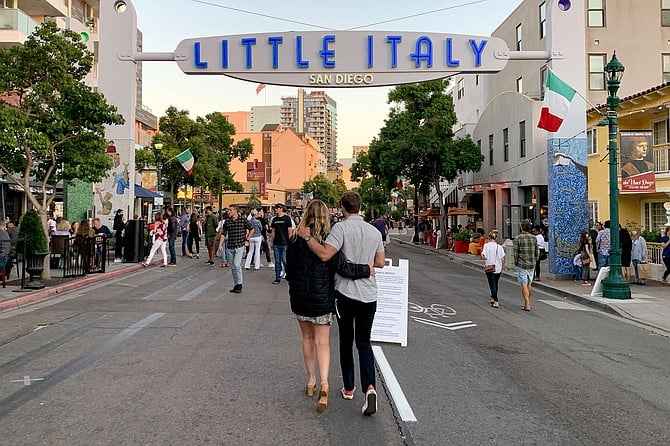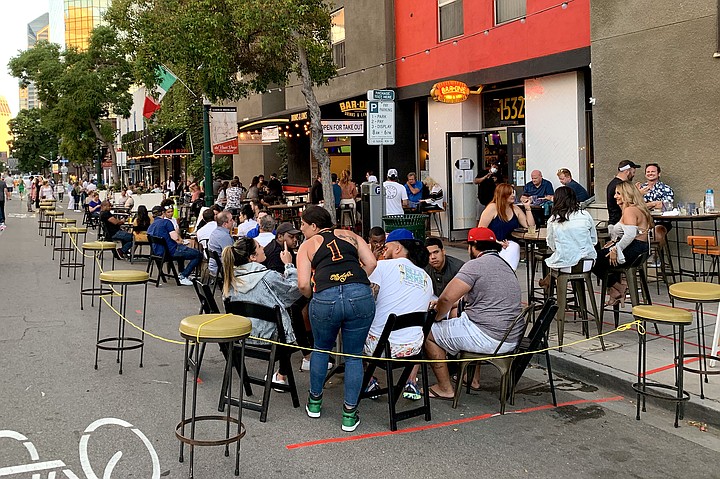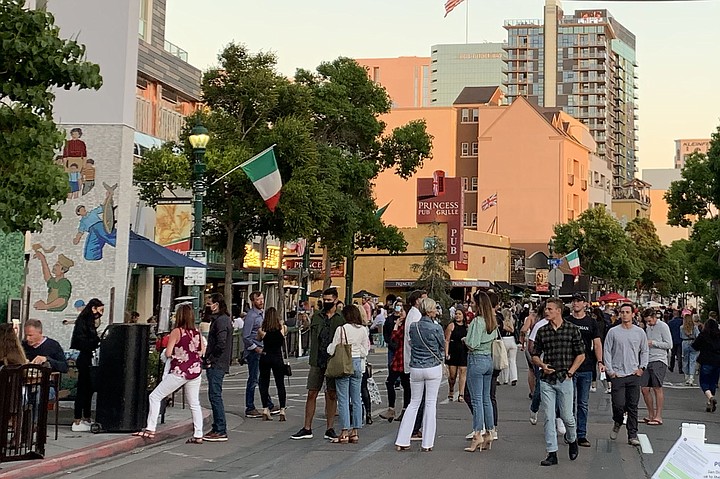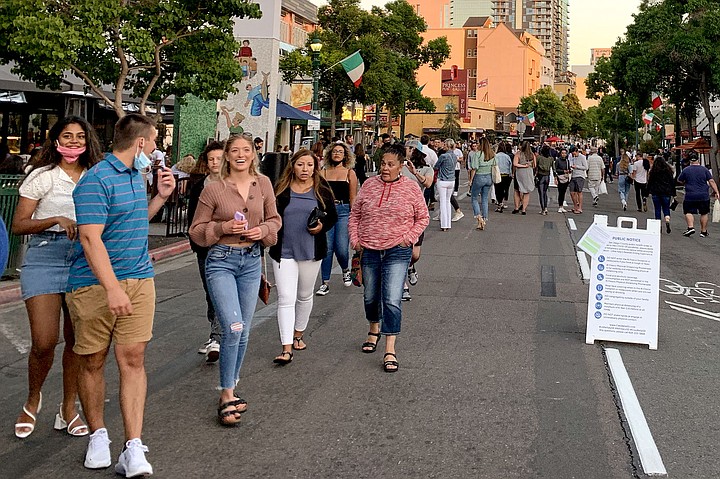 Facebook
Facebook
 X
X
 Instagram
Instagram
 TikTok
TikTok
 Youtube
Youtube

It was a good night for the restaurants, I have no doubt. On Saturday, June 13, Little Italy closed streets to car traffic and allowed restaurants to extend their seating out onto the asphalt.
The neighborhood was San Diego’s first to try a concept being tested in many cities across the United States, including New York City, Chicago, Detroit, and Washington D.C. The reasoning behind the move is that the risk of airborne coronavirus transmission is thought to be far greater indoors than outside. So, by setting up more outdoor seating, diners who don’t feel ready to be seated within the confines of a restaurant, might venture out for al fresco table service.
For restaurants, it mitigates a significant problem. The social distancing guidelines required to re-open during a pandemic mean that most eateries can only seat about half their usual number of diners. So, while they may be open for business, they may not physically be able to do enough business to cover the costs of doing business. Being allowed to set up outdoor tables theoretically gives them room to serve more customers.
Take India Street restaurant Bar One, for example. By the looks of things, the tiny restaurant was able to seat more diners outside on this evening than it would be able to indoors under normal circumstances. Dozens gathered among outdoor tables, roped off from the street with the help of bar stools. And, like most of the neighborhood’s restaurants, potential diners gathered outside, just before dusk, awaiting tables.

And therein lies the problem. This closing of the streets dining event attracted crowds. Outside virtually every restaurant, clusters of San Diegans gathered, vying for outdoor tables. And by my count, the vast majority of people who came to Little Italy for al fresco dining were not wearing masks.
It feels counterintuitive to harp on this point, given the preceding week of protests that saw thousands of Black Lives Matter activists take to the streets demanding police reforms. But on this night in Little Italy, it seemed as though people had either forgotten the covid-19 outbreak is active, or had decided they do not care.

Lines outside of restaurants, combined with hundreds of prospective diners crowding the streets, made it difficult, and at times impossible, to maintain the six-foot rule. People did what people tend to do when walking together in crowds: walk at different paces, stop to chat with friends, compress at bottlenecks, edge around one another.
I don’t mean to sound judgmental: I showed up, like everyone else, for the implicit romance of al fresco dining, under clear skies, in beautiful weather, in what reigns as the city’s best dining neighborhood. However, in a county bracing for a surge in coronavirus infections due to re-opening of businesses and beaches, and which is tracking at least one outbreak of cases connected to a local restaurant, the numbers of unmasked revelers in Little Italy on Saturday night was troubling.

Word is, Little Italy plans to try this again on June 20, and I would expect similar, if not greater crowds to attend. But I think it’s fair to question whether the mitigated risk of outdoor dining is compromised by the sheer volumes of people taking to the streets. Perhaps if multiple neighborhoods opened streets to dining at the same time, the population would be better distributed. Or if restaurants were restricted to reservations only, fewer diners would cluster outside restaurants in search of a table.
For those who do plan to attend future street closings, I would suggest reservations are an must, and to be explicit about wishing to dine outdoors. Everybody wants to eat outside, but the restaurants are still seating guests in their dining rooms, and it seems pointless to me to brave the crowds in the street, only to dine indoors.
And if you’re concerned about the risk of covid-19, avoid Little Italy’s outdoor dining experiment altogether. Counting on fellow San Diegans to limit the spread of the virus doesn’t feel realistic. And restaurants open in San Diego are more than happy to serve you take-out.


It was a good night for the restaurants, I have no doubt. On Saturday, June 13, Little Italy closed streets to car traffic and allowed restaurants to extend their seating out onto the asphalt.
The neighborhood was San Diego’s first to try a concept being tested in many cities across the United States, including New York City, Chicago, Detroit, and Washington D.C. The reasoning behind the move is that the risk of airborne coronavirus transmission is thought to be far greater indoors than outside. So, by setting up more outdoor seating, diners who don’t feel ready to be seated within the confines of a restaurant, might venture out for al fresco table service.
For restaurants, it mitigates a significant problem. The social distancing guidelines required to re-open during a pandemic mean that most eateries can only seat about half their usual number of diners. So, while they may be open for business, they may not physically be able to do enough business to cover the costs of doing business. Being allowed to set up outdoor tables theoretically gives them room to serve more customers.
Take India Street restaurant Bar One, for example. By the looks of things, the tiny restaurant was able to seat more diners outside on this evening than it would be able to indoors under normal circumstances. Dozens gathered among outdoor tables, roped off from the street with the help of bar stools. And, like most of the neighborhood’s restaurants, potential diners gathered outside, just before dusk, awaiting tables.

And therein lies the problem. This closing of the streets dining event attracted crowds. Outside virtually every restaurant, clusters of San Diegans gathered, vying for outdoor tables. And by my count, the vast majority of people who came to Little Italy for al fresco dining were not wearing masks.
It feels counterintuitive to harp on this point, given the preceding week of protests that saw thousands of Black Lives Matter activists take to the streets demanding police reforms. But on this night in Little Italy, it seemed as though people had either forgotten the covid-19 outbreak is active, or had decided they do not care.

Lines outside of restaurants, combined with hundreds of prospective diners crowding the streets, made it difficult, and at times impossible, to maintain the six-foot rule. People did what people tend to do when walking together in crowds: walk at different paces, stop to chat with friends, compress at bottlenecks, edge around one another.
I don’t mean to sound judgmental: I showed up, like everyone else, for the implicit romance of al fresco dining, under clear skies, in beautiful weather, in what reigns as the city’s best dining neighborhood. However, in a county bracing for a surge in coronavirus infections due to re-opening of businesses and beaches, and which is tracking at least one outbreak of cases connected to a local restaurant, the numbers of unmasked revelers in Little Italy on Saturday night was troubling.

Word is, Little Italy plans to try this again on June 20, and I would expect similar, if not greater crowds to attend. But I think it’s fair to question whether the mitigated risk of outdoor dining is compromised by the sheer volumes of people taking to the streets. Perhaps if multiple neighborhoods opened streets to dining at the same time, the population would be better distributed. Or if restaurants were restricted to reservations only, fewer diners would cluster outside restaurants in search of a table.
For those who do plan to attend future street closings, I would suggest reservations are an must, and to be explicit about wishing to dine outdoors. Everybody wants to eat outside, but the restaurants are still seating guests in their dining rooms, and it seems pointless to me to brave the crowds in the street, only to dine indoors.
And if you’re concerned about the risk of covid-19, avoid Little Italy’s outdoor dining experiment altogether. Counting on fellow San Diegans to limit the spread of the virus doesn’t feel realistic. And restaurants open in San Diego are more than happy to serve you take-out.
Comments